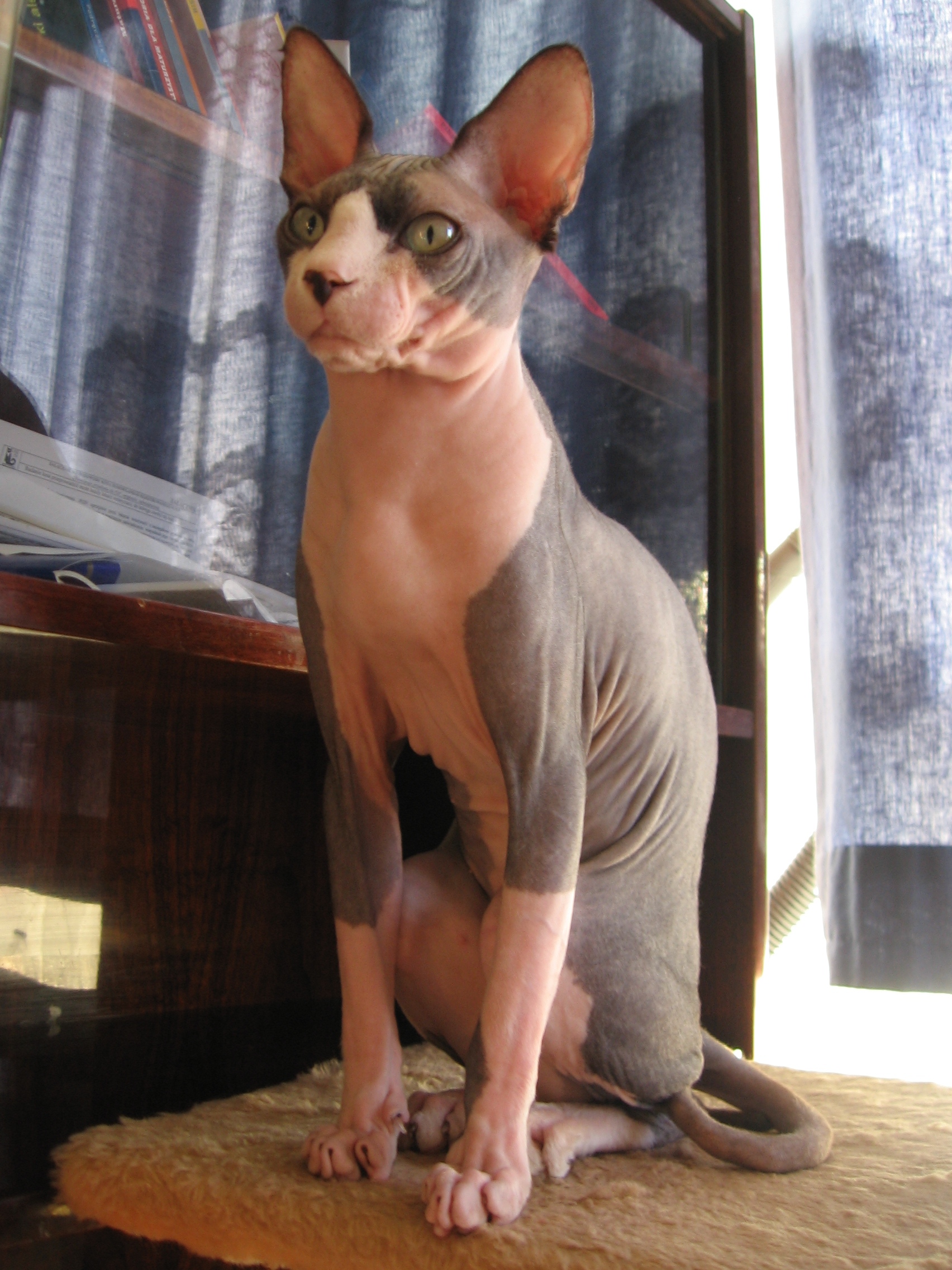- Sphynx (cat)
Infobox Catbreed
name = Sphynx

imagecaption =
altname = Canadian Hairless
nickname =
country =Canada
aacestd = http://www.aaceinc.org/pages/breeds/sph.htm
cfastd = http://www.cfainc.org/breeds/standards/sphynx.html
acfastd =
ticastd =
ccastd =
acfstd =
gccfstd =
fifestd = http://www.fifeweb.org/wp/breeds/std/sph_std.html
otherstd =
notrecognized =
extinct =
note = | The Sphynx (also known as Canadian Hairless) is a rare breed ofcat known for its lack of a coat.Origin
Hairless cat s have been described in many regions of theworld , but the first successful breed was the Sphynx. The earliest Sphynx wasborn in 1966, and the cat was named Prune. However, Prune’s line died out without descendants. In 1967, hairless kittens, and their longhaired mother cat were rescued inToronto . The kittens wereneutered ; the mother, however, had other kittens. Two were exported toEurope , where one of the kittens was bred to aDevon Rex . The cat had hairless offsprings which implied that this recessive gene was at the same locus as the Devon geneDubious|date=September 2008. One, named E.T., was presented by Vicki and Peter Markstein at theMadison square garden cat show in the 1980s. [Bruce Fogle, New Encyclopedia of the Cat. ISBN 0789480212]Characteristics
The Sphynx appears to be a hairless cat, although it is not truly hairless. The skin should have the texture of
Chamois leather . It may be covered with very soft hair that is often described as peach fuzz. Because the sphynx cats have no hair to keep them warm they prefer to cuddle up against other animals and people, they even tend to cuddle up and sleep with their owners under the covers. Lack of coat makes the cat quite warm to the touch. Whiskers and eyebrows may be present, either whole or broken, or may be totally absent. Their skin is the color their fur would be, and all the usual cat marking patterns (solid, point, van, tabby, tortie, etc) may be found in Sphynx too.Sphynxes generally have wedge-shaped heads and sturdy, heavy bodies. Many cats of this breed develop pot bellies.
Sphynxes are known for their extroverted behavior. They display a high level of energy, intelligence, curiosity, and affection for their owners. [ [http://animal.discovery.com/breedselector/catprofile.do?id=4070 Animal Planet :: Cat Breed Profile :: Sphynx ] ]
Care
While sphynx cats lack a coat to shed or groom, they are not maintenance-free. Body oils, which would normally be absorbed by the hair, tend to build up on the skin. As a result, regular cleaning (usually in the form of bathing) is necessary; one bath a week is usually sufficient. [ [http://www.cfainc.org/breeds/profiles/sphynx.html CFA Sphynx Breed Profile] ] Care should be taken to limit the Sphynx cat's exposure to outdoor sunlight at length, as they can develop a sunburn, similar to that of human exposure. In general, Sphynx cats should never be allowed outdoors unattended, as they have limited means to conserve body heat in colder temperatures, and their curious nature can take them into dangerous places or situations.
Although Sphynx cats are sometimes thought to be
hypoallergenic due to their lack of coat, this is not always the case. Allergies to cats are triggered bydander , and not cat hair itself. Those with cat allergies may react worse to direct contact with Sphynx cats than other breeds. However, conflicting reports of some people successfully tolerating Sphynx cats also exist. [ [http://www.ankhamun.com/Hypoallergenic%20cats.htm The Big Question ] ] .Breeding
Although hairless cats have been reported throughout history (hairless cats seem to appear naturally about every 15 years or so)Fact|date=September 2008, breeders in Europe have been working on the Sphynx breed since the early 1960s. The current American and European Sphynx breed is descended from two lines of natural mutations:
* Dermis and Epidermis (1975) from the Pearsons ofWadena, Minnesota , USA.
* Bambi, Punkie, and Paloma (1978) found in Toronto, ON, Canada and raised by Shirley Smith.Other hairless breeds might have different body shapes or temperaments than those described above. There are, for example, new hairless breeds, including the
Don Sphynx and thePeterbald from Russia, which arose from their own spontaneous mutations. The standard for the Sphynx differs between cat associations such as TICA, FIFE and CFA.It has been theorized that Sphynx hairlessness might be produced by an
allele of the samegene that produces theDevon Rex (re), with the Sphynx allele being incompletely dominant over the Devon allele and both recessive to the wild type. However a different genetic symbol (hr) is given to the Sphynx gene and it is more likely that these are different genes interacting with each other. Sphynx were at one time crossbred with Devon Rex, but unfortunately this led to the introduction of some genetic diseases and is now forbidden in most breed standards associations. Hereditary spasticity and Hypertrophic Cardiomyopathy (a genetic heart defect) were introduced by the Devon Rex breed. The only allowable outcross breeds in the [http://www.cfainc.org/ CFA] are now theAmerican Shorthair and Domestic Shorthair. Other associations may vary and the Russian Blue is a permitted outcross in the GCCF. In Europe mainly Devon Rex has been used for outcrosses.In 1999 [http://www.classicalcats.com/nordstrom.shtml SGC Apophis Nordstrom of Classical Cats] won the TICA International Alter of the Year. In 2006 [http://www.classicalcats.com/gallery/SGCClassicalCatsValentino01 SGC Classical Cats Valentino] won the TICA International Cat of the year. In the Cat Fancier's Association, [http://www.sphynx.nu/index/Sillyhomepage.jpgGC, RW, NW Majikmoon Will Silver With Age] was Cat of the Year for 2006. The following year, [http://www.sphynxbc.org/images/cornflakegirl2.jpgGC, RW, NW Enchantedlair NWA Cornflake Girl] was Kitten of the Year. These awards are handed out for the highest scoring cats, across all breeds during the current show seaons.References
External links
* [http://www.candelasphynx.com/ more photos sphynx cats]
* [http://www.sphynxphotos.com/ Sphynxphotos.com]
* [http://www.sphynxcats.eu/ Sphynx Cats]
Wikimedia Foundation. 2010.
